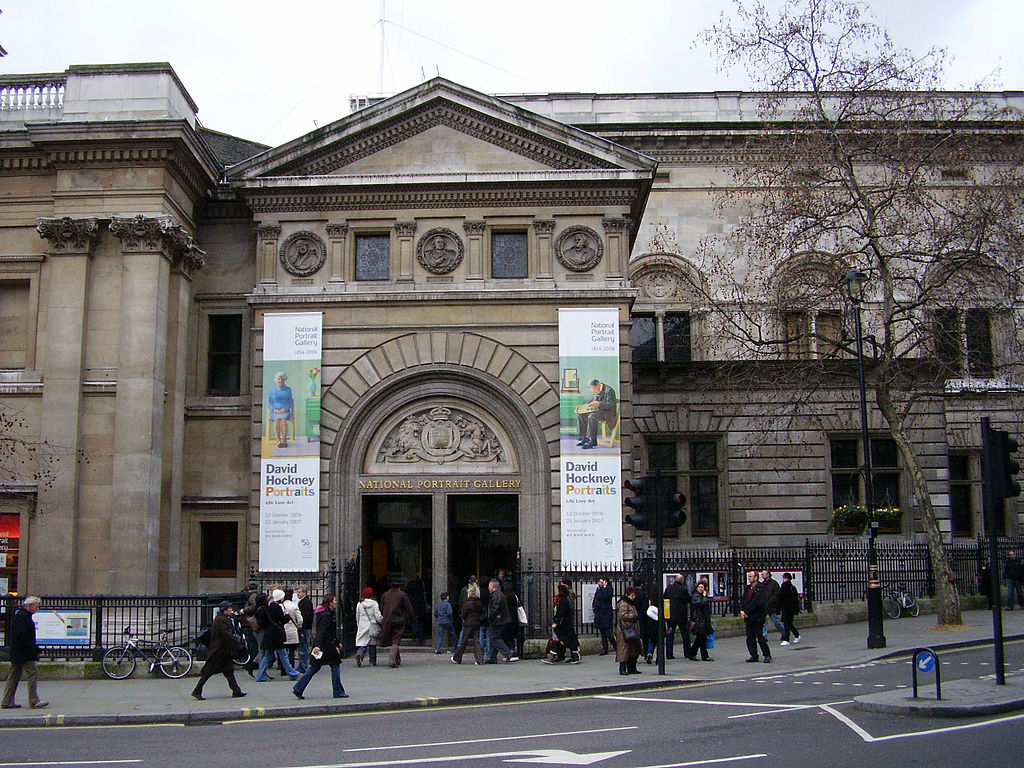The National Portrait Gallery houses a collection of portraits of historical importance and more recent famous British people.
It was the first portrait gallery in the world, established in 1856.
Since then, it has expanded include regional centers at Beningbrough Hall in Yorkshire and Montacute House in Somerset.
Virtual Tour of the National Portrait Gallery, London
- “The Chandos Portrait of William Shakespeare” by John Taylor
- Elizabeth I of England
- King Edward VI of England
- Catherine of Aragon
- Self Portrait by Dante Gabriel Rossetti
- “Frederick Sleigh Roberts, 1st Earl Roberts” by John Singer Sargent
- “Sir Winston Leonard Spencer Churchill” by Ambrose McEvoy
- “Winston Churchill” by Walter Sickert
The Tudors with 16th Century Curator
Highlights Tour of the National Portrait Gallery, London
“The Chandos Portrait of William Shakespeare” by John Taylor
“The Chandos Portrait of William Shakespeare” is believed to depict Shakespeare (1564–1616), because the engraved portrait of Shakespeare, on the title page of the first publication of his works, shows distinct similarities when compared to this painting.
It has not been possible to determine with certainty who painted the portrait, nor whether it depicts Shakespeare.
Elizabeth I of England
This portrait of Elizabeth I of England in her coronation robes shows the Queen crowned, wearing the cloth of gold for her coronation and holding the symbols of her authority, the orb and scepter.
The date of her accession on 15th January 1559 was a day of celebration, with tournaments and the ringing of bells in parishes across England.
Queen Mary I, previously wore the cloth of gold in this portrait, and the order to the Queen’s tailor for the remodeling of Queen Mary I’s fabric of gold coronation robes for Elizabeth survives.
The painting reflects the written records. However, it is not known why, and for whom, these portraits were created, at or just after the end of the reign in 1603.
King Edward VI of England
This portrait of King Edward VI of England shows Edward in a wide-legged pose that mimics his father Henry VIII’s famous pictures where he stands with his feet and hands similarly positioned.
The portrait was started when Edward was a prince and completed after he became King with the addition of his coat of arms in the top left.
Edward VI (1537 – 1553) was King of England and Ireland for six years, from 1547 until his death. He was crowned at the age of nine and was the son of Henry VIII and Jane Seymour.
It was during Edward’s reign that Protestantism was established in England with reforms that included the abolition of clerical celibacy and the Mass and the imposition of compulsory services in English.
Catherine of Aragon
“Catherine of Aragon” depicts the first wife of King Henry VIII. The daughter of Isabella I of Castile and Ferdinand II of Aragon, Catherine was betrothed to Arthur, Prince of Wales, heir apparent to the English throne.
They married in 1501, but Arthur died five months later. Catherine subsequently married Arthur’s younger brother, King Henry VIII, in 1509.
Dante Gabriel Rossetti – Self Portrait
Self Portrait by Dante Gabriel Rossetti depicts the young artist at age 18. He drew this self-portrait when he was a student at the Royal Academy.
Rossetti has captured the rebellious and romantic self-image he had of himself.
Rosetti would go on to become the founder of a new artistic and poetic movement, the Pre-Raphaelite Brotherhood.
“Frederick Sleigh Roberts, 1st Earl Roberts” by John Singer Sargent
“Frederick Sleigh Roberts, 1st Earl Roberts” by John Singer Sargent depicts a British Victorian era general who became a successful British military commander.
Frederick Sleigh Roberts (1832 – 1914) was born in India and joined the East India Company Army and served as an officer in the Indian Rebellion, during which he won a Victoria Cross for gallantry.
He was then transferred to the British Army and fought in Abyssinia and in the Second Anglo-Afghan War, in which his exploits earned him widespread fame. Roberts served as the Commander-in-Chief, India, before leading British Forces in the Second Boer War.
Roberts became a symbol for the British Army and became an influential proponent of the increasing threat that the German Empire posed to Britain in the lead up to the First World War.
National Portrait Gallery, London
- Museum: National Portrait Gallery, London
- City: London
- Country: England
- State: United Kingdom
- Established: 1856
- Location: Saint. Martin’s Place, London, United Kingdom
The Stuarts with 17th Century Curator
Explore London’s Museums and Heritage Sites
- The British Museum
- The National Gallery, London
- Tate Britain
- The Wallace Collection
- The Victoria and Albert Museum
- Queen’s Gallery, Buckingham Palace
- Courtauld Gallery
- Tate Modern, London
- Science Museum, London
- National Portrait Gallery, London
- Natural History Museum
- Charles Dickens Museum
- Hampton Court Palace
- Sherlock Holmes Museum
- British Library
- Imperial War Museum
Map for National Portrait Gallery, London
Rebellion to Reform with 18th Century Curator
Regency Period with 18th Century Curator
The Victorians with 19th Century Curator
The Twentieth Century with 20th Century Curator
~~~
“Museums should be places where you raise questions, not just show stuff.”
– William Thorsell
~~~
Photo Credit: By Ham (Own work) [GFDL (http://www.gnu.org/copyleft/fdl.html) or CC-BY-SA-3.0 (http://creativecommons.org/licenses/by-sa/3.0/)], via Wikimedia Commons
SEARCH Search for: Search Follow UsJoin – The JOM Membership Program
Sponsor a Masterpiece with YOUR NAME CHOICE for $5
Share this:
- Tweet

